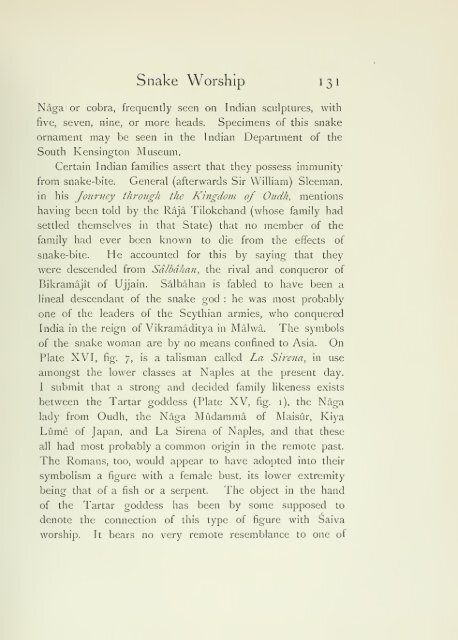Download Ebook - Free History Ebooks
Download Ebook - Free History Ebooks
Download Ebook - Free History Ebooks
You also want an ePaper? Increase the reach of your titles
YUMPU automatically turns print PDFs into web optimized ePapers that Google loves.
Snake Worship 131<br />
Naga or cobra, frequently seen on Indian sculptures, with<br />
five, seven, nine, or more heads. Specimens of this snake<br />
ornament may be seen in the Indian Department of the<br />
South Kensington Museum.<br />
Certain Indian families assert that they possess immunity<br />
from snake-bite. General (afterwards Sir William) Sleeman,<br />
in his Jotcntey through the Kingdom of Oucih, mentions<br />
having been told by the Raja Tilokchand (whose family had<br />
settled themselves in that State) that no member of the<br />
family had ever been known to die from the effects of<br />
snake-bite. He accounted for this by saying that they<br />
were descended from Sdlbdhan, the rival and conqueror of<br />
Bikramajit of Ujjain. Salbahan is fabled to have been a<br />
lineal descendant of the snake god :<br />
he was most probably<br />
one of the leaders of the Scythian armies, who conquered<br />
India in the reign of Vikramaditya in Malwa. The symbols<br />
of the snake woman are by no means confined to Asia. On<br />
Plate XVI, fig. 7, is a talisman called La Sircna, in use<br />
amongst the lower classes at Naples at the present day.<br />
I submit that a strong and decided family likeness exists<br />
between the Tartar goddess (Plate XV, fig. i), the Naga<br />
lady from Oudh, the Naga Mudamma of Maisiir, Kiya<br />
LCime of Japan, and La Sirena of Naples, and that these<br />
all had most probably a common origin in the remote past.<br />
The Romans, too, would appear to have adopted into their<br />
symbolism a figure with a female bust, its lower extremity<br />
being that of a fish or a serpent. The object in the hand<br />
of the Tartar goddess has been by some supposed to<br />
denote the connection of this type of figure with Saiva<br />
worship. It bears no very remote resemblance to one of

















